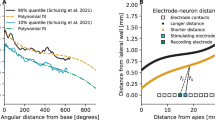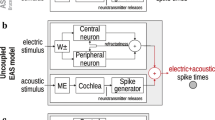Abstract
The objective of the study was to explore the effect of electrode encapsulation by fibrous scar tissue on electrical potential distributions and auditory nerve fibre excitation patterns. A finite element model in combination with an auditory nerve fibre model was used to predict changes in threshold currents and auditory nerve fibre excitation patterns. The model showed that electrical potentials at the target nerve fibres and the electrode contacts changed in the presence of encapsulation tissue. This led to changes in threshold currents and spread of excitation. The effect of electrode encapsulation on threshold currents and spread of excitation depended on the thickness of the perilymph layer separating the fibrous tissue encapsulation and the electrode array, nerve fibre survival status, electrode geometry and configuration, and array location. Model results suggested that arrays located close to the modiolus were most sensitive to threshold changes caused by electrode encapsulation (changes were between −0.26 and 2.41 dB), whereas encapsulation of an electrode array had less effect on threshold currents when the array was located in a lateral position in the scala tympani (changes were between −0.64 and 1.5 dB). For medially located arrays, changes in the spread of excitation varied between an increase of 0.21 mm and a decrease of 0.33 mm along the length of the basilar membrane, and an increase of 0.18 mm and a decrease of 0.66 mm along the length of the basilar membrane were calculated for laterally located arrays.
Similar content being viewed by others
References
Balkany, T. J., Eshraghi, A. A., andYang, N. (2002): ‘Modiolar proximity of three perimodiolar cochlear implant electrodes’,Acta Otolaryngologica,122, pp. 363–369
Bertoluzza, A., Fagnano, C., Monti, P., Simoni, R., Tinti, A., Tosi, M. R., andCaramazza, R. (1992): ‘Raman spectroscopy in the study of biocompatibility»,Clin. Mater.,9, pp. 49–68
Black, R. C., Clark, G. M., andPatrick, J. F. (1981): ‘Current distribution measurements within the human cochlea’,IEEE Trans. Biomed. Eng.,28, pp. 721–724
Brown, C. J., Abbas, P. J., Bertschy, M., Tyler, R. S., Lowder, M., Takahashi, G., Purdy, S., andGantz, B. J. (1995): ‘Longitudinal assessment of physiological and psychophysical measures in cochlear implant users’,Ear Hearing,16, pp. 439–449
Clark, G. M., Shute, S. A., Shepherd, R. K., andCarter, T. D. (1995): ‘Cochlear implantation: Osteoneogenesis, electrode-tissue impedance, and residual hearing’,Ann. Otol., Rhinol. Laryngol. Suppl. (United States),166, pp. 40–42
Clark, G. M. (1996): ‘Electrical stimulation of the auditory nerve: the coding of frequency, the perception of pitch and the development of cochlear implant speech processing strategies for profoundly deaf people’,Clin. Exp. Pharmacol. Physiol.,23, pp. 766–776
Cohen, L. T., Saunders, E., andClark, G. M. (2001): ‘Psychophysics of a prototype peri-modiolar cochlear implant electrode array’,Hearing Res.,155, pp. 63–81
Cohen, L. T., Richardson, L. M., Saunders, E., andCowan, R. S. (2003): ‘Spatial spread of neural excitation in cochlear implant recipients: comparison of improved ECAP method and psychophysical forward masking»,Hearing Res.,179, pp. 72–78
de Sauvage, R. C., Da Costa, D. L., Erre, J.-P., andAran, J. M. (1997): ‘Electrical and physiological changes during short-term and chronic electrical stimulation of the normal cochlea’,Hearing Res.,110, pp. 119–134
Dorman, M. F., Smith, L. M., Dankowski, K., McCandless, G., andParkin, J. L. (1992): ‘Long-term measures of electrode impedance and auditory thresholds for the Ineraid cochlear implant’J. Speech Hearing,35, pp. 1126–1130
Eddington, D., Dobelle, W., Brackmann, D. E., Mladejousky, M. andParkin, J. L. (1988): ‘Auditory prosthesis research with multiple channel intracochlear stimulation in man’,Ann. Otol. Rhinol. Laryngol. Suppl.,87, pp. 5–39
Engström, H., Ades, H. W., andBredberg, G. (1970): ‘Normal structure of the organ of Corti and the effect of noise-induced cochlear damage’ inWolstenholme, G. E. W. andKnight, J. (Eds): ‘Sensorineural hearing loss’ (J. & A. Churchill, London, 1970)
Finley, C. C., Wilson, B. S., andWhite, M. W. (1990): ‘Models of neural responsiveness to electrical stimulation’, inMiller, J. M. andSpelman, F. A. (Eds), ‘Cochlear implants’ (Springer-Verlag Inc., New York, 1990), pp. 55–96
Frijns, J. H. M., De Snoo, S. L., andSchoonhoven, R. (1995): ‘Potential distributions and neural excitation patterns in a rotationally symmetric model of the electrically stimulated cochlea’,Hearing Res.,87, pp. 170–186
Frijns, J. H. M., De Snoo, S. L., andTen Kate, J. H. (1996): ‘Spatial selectivity in a rotationally symmetric model of the electrically stimulated cochlea’,Hearing Res.,95, pp. 33–38
Frijns, J. H. M., Briaire, J. J., De Laat, J. A. P. M., andGrote, J. J. (2002): ‘Initial evaluation of the Clarion CH cochlear implant: Speech perception and neural response imaging’,Ear Hearing,23, pp. 184–197
Grill, W. M., andMortimer, J. T. (1994): ‘Electrical properties of implant encapsulation tissue’,Ann. Biomed. Eng.,22, pp. 23–33
Gstoettner, W., Adunka, O., Franz, P., Hamzavi, J., Plenk, H. Jr., Susani, M., Baumgartner, W., andKiefer, J. (2001): ‘Perimodiolar electrodes in cochlear implant surgery’,Acta Otolaryngologica,121, 216–219
Hanekom, T. (2001): ‘Three-dimensional spiraling finite element model of the electrically stimulated cochlea’,Ear Hearing,22, pp. 300–315
Jolly, C. N., Clopton, B. M., Spelman, F. A., andLineaweaver, S. K. (1997): ‘Guinea pig auditory nerve response triggered by a high density electrode array’,Med. Progr Technol.,21, pp. 13–23
Kawano, A., Seldon, H. L., Clark, G. M., Ramsden, R. T., andRaine, C. H. (1998): ‘Intracochlear factors contributing to psychophysical percepts following cochlear implantation’,Acta Oto-Laryngologica,118, pp. 313–326
Kessler, D. K. (1999): ‘The Clarion multi-strategy cochlear implant’,Ann. Otol., Rhinol. Laryngol.,108, pp. 8–16
Leake, P. A., Snyder, R. L., Hradek, G. T., andRebscher, S. J. (1992): ‘Chronic intracochlear electrical stimulation in neonatally deafened cats: Effects of intensity and stimulating electrode location’,Hearing Res.,64, pp. 99–117
Linthicum, F. H. Jr., Fayad, J., Otto, S. R., Galey, F. R., andHouse, W. F. (1991): ‘Cochlear implant histopathology’,Am. J. Otol.,12, pp. 245–311
Miller, A. L., Morris, D. J., andPfingst, B. E. (2000): ‘Effects of time after deafening and implantation on guinea pig electrical detection thresholds’,Hearing Res.,144, pp. 175–186
Nanas, N. N. (1988): ‘Blocompatibility overview: Classes of materials, inflammation, infection’, inWebster, J. G. (Ed.): ‘Encyclopedia of medical devices and instrumentation’ (Wiley, 1988), pp. 181–194
Pfingst, B. E. (1990): ‘Changes over time in thresholds for electrical stimulation of the cochlea’,Hearing Res.,50, pp. 225–236
Reilly, J. P., Freeman, V. T., andLarkin, W. D. (1985): ‘Sensory effects of transient electrical stimulation. Evaluation with a neuroelectric model’,IEEE Trans. Biomed. Eng.,32, pp. 1001–1011
Seldon, H. L., Dahm, M. C., Clark, G. M., andCrowe, S. (1994): ‘Silastic with polyacrylic acid filler: Swelling properties, biocompatibility and potential use in cochlear implants’,Biomaterials,15, pp. 1161–1169
Shepherd, R. K., Hatsushika, S.-I., andClark, G. M. (1993): ‘Electrical stimulation of the auditory nerve. The effect of electrode position on neural excitation’,Hearing Res.,66, pp. 108–120
Skinner, M. W., Ketten, D. R., Vannier, M. W., Gates, G. A., Yoffie, R. L., andKalender, W. A. (1994): ‘Determination of the position of Nucleus cochlear implant electrodes in the inner ear’,Am. J. Otol.,15, pp. 644–651
Spelman, F. A., Pfingst, B. E., Miller, J. M., Hassul, M., andPowers, W. E. (1980): ‘Biophysical measurements in the implanted cochlea’,Oto-Laryngol.: Head-Neck Surg.,88, pp. 183–187
Spelman, F. A., Clopton, B. M., andPfingst, B. E. (1982): ‘Tissue impedance and current flow in the implanted ear. Implications for the cochlear prosthesis’,Ann. Otol. Rhinol. Laryngol. Suppl. (United States),91, pp. 3–8.
Spelman, F. A., Clopton, B. M., Clary, T., Corbett, S., Jolly, C. N., Voie, A. H., Rodenhiser, K. L., andLineaweaver, S. K. (1996): ‘Potential field focussing and the design of cochlear electrode arrays’. 18th Ann. Int. Conf. IEEE EMBS. Amsterdam, pp. 329–330
Spoendlin, H., andSchrott, A. (1989): ‘Analysis of the human auditory nerve’,Hearing Res.,43, pp. 25–38
Tye-Murray, N., Tyler, R. S., Woodworth, G. G., andGantz, B. J. (1992): ‘Performance over time with Nucleus or Ineraid cochlear implant’,Ear Hearing,13, pp. 200–209
Tykocinski, M., Saunders, E., Cohen, L. T., Treaba, C. G., Briggs, R. J. S., Gibson, P., Clark, G. M., andCowan, R. S. (2001): ‘The Contour electrode array: Safety study and initial patient trials of a new perimodiolar design’,Otol. Neurotol.,22, pp. 33–41
Webb, R. L., Clark, G. M., Shepherd, R. K., Franz, B. K., andPyman, B. C. (1988): ‘The biological safety of the Cochlear Corporation multiple-electrode intracochlear implant’,Am. J. Otol.,9, pp. 8–13
Young, N. M., andGrohne, K. M. (2001): ‘Comparison of pediatric Clarion recipients with and without the electrode positioner’,Otol. Neurotol.,22, pp. 195–199
Zappia, J. J., Niparko, J. K., Oviat, D. L., Kemink, J. L., andAltschuler, R. A. (1991): ‘Evaluation of the temporal bones of a multichannel cochlear implant patient’,Ann. Otol. Rhinol. Laryngol.,100, pp. 914–921
Zwicker, E., andFastl, H. (1990): ‘Psychoacoustics: Facts and models’, (Springer-Verlag, Berlin, Heidelberg, 1990)
Author information
Authors and Affiliations
Corresponding author
Rights and permissions
About this article
Cite this article
Hanekom, T. Modelling encapsulation tissue around cochlear implant electrodes. Med. Biol. Eng. Comput. 43, 47–55 (2005). https://doi.org/10.1007/BF02345122
Received:
Accepted:
Issue Date:
DOI: https://doi.org/10.1007/BF02345122




